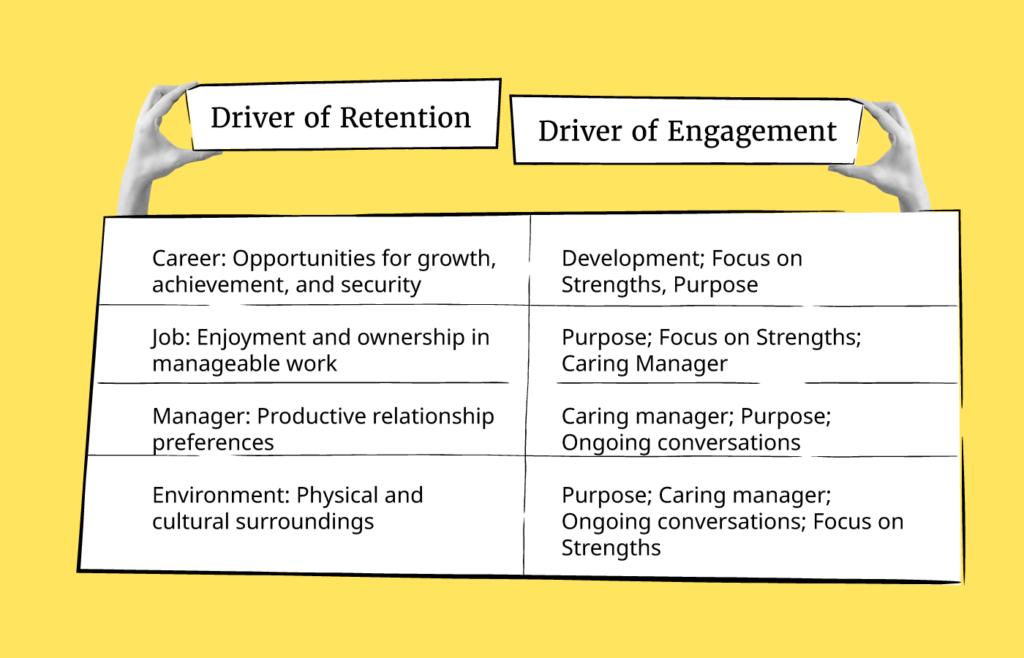A clear vision and mission are the bedrock of employee engagement. Think about the number of volunteers worldwide who contribute their energy to causes they care about and expect nothing in return.
When it comes to employee engagement strategies, start with the why and build from there. In this article, I’ll take you through how to increase employee engagement in your organization.
- Champion the “Why”
- Put the right people in the right seats
- Provide growth and development opportunities
- Gather feedback
- Provide regular feedback
- Show appreciation
- Prioritize wellness and wellbeing
- Onboarding—the crucial first impression
- Employee Engagement Tools
- Volunteering
- social outings
- Passion Projects
12 Ways To Increase Employee Engagement
1. Champion the “Why”
When you know and communicate your “why,” you're more passionate about your work and you’re more able to push through hard times because you know the importance of what you do.
Don’t buy it? Check out this video I regularly show to fellow leaders and team members that demonstrates the awesome power of “why”.
Pretty powerful, right? And it doesn’t have to be a grandiose purpose either, as long as people understand why their work matters to the overall success of the organization (bonus if it is also tied to their career progression too!).
2. Put the right people in the right seats
If the right people are in the right positions and empowered to perform to the best of their ability, employee engagement metrics will look a lot more positive.
Not everyone excels in the same areas. This is seen within day-to-day operations and conversations with staff about their strengths and areas of improvement—and it’s often reflected within performance evaluations.
It's up to managers to understand individual employees enough to know the areas in which they excel and then put them there whenever possible.
3. Provide growth and development opportunities
Engaged employees are those that are clear about their job expectations and know how to meet those expectations.
Help employees get a strong start with clear and accurate training related to their job roles, then ensure management is present for continued coaching after the initial probationary period has ended.
Professional development and growth are important for the vast majority of people, especially your top talent.
While it’s true that people are responsible for their own development, if you want it to be at your organization then you should at least meet them halfway and provide opportunities to help them develop.
This can be done by establishing clear job roles, providing coaching and mentorship programs, paying for courses and accreditations, providing company time to work on personal development, temporary assignments, stretch projects, job rotations—the list goes on!
4. Gather feedback
If you’re not willing to listen, it's likely your staff don’t feel respected or heard—a significant contributing factor to disengagement.
Be willing to gather and listen to employee feedback, even if you don’t have the same perspective. Trust me, your staff are likely to have better employee engagement ideas than you do.
Ways you can gather feedback to assess employee engagement include:
- Formal employee engagement surveys
- Conducting interviews such as stay interviews
- Regular check-ins between managers and team members.
My advice is to be transparent when you’re collecting feedback—tell your team members why you’re collecting it and the goals you hope to achieve from it.
Consider asking targeted engagement questions like:
- What motivates you to wake up and come to work every day?
- What’s your favorite part of your job?
- What’s something you’ve done with our company you're most proud of?
- Can you think of one new thing you’d like to work on or do differently?
- Is there something about your job that you really don’t like?
- After ___ months/years with our company, how do you feel overall?
An open and honest conversation will likely yield more information and also help build rapport and trust.
It doesn’t necessarily mean you have to make changes—and sometimes as leaders we can’t—but at minimum your team members will feel valued and heard. If no action can be taken, communicate why.
5. Provide regular feedback
Research shows that employees crave regular feedback.
Team members should always have a good idea of how they’re performing and how their work is contributing to organizational success.
This will help motivate employees by reinforcing impactful behaviors and opening up conversations about advancement and career progression.
It will also nip any deviation from priorities or performance issues in the bud, long before they turn in to an official work performance improvement plan.
Regular check-ins between managers and direct reports are crucial here and, to increase the usefulness of feedback, I’d also advise experimenting with other methods such as 360 reviews that gather feedback from peers, customers and other stakeholders.
Be willing to have uncomfortable conversations and address issues you see early on, rather than waiting for them to become bigger problems down the line.
6. Show appreciation
Employee recognition is paramount to a strong workplace culture and increased engagement. So, be sure you’re recognizing wins of all sizes on a regular basis.
There are many effective ways to recognize staff milestones and they don’t have to be extravagant. Consider things like:
- Stopping by their door to let them know you saw the win and you appreciate their work
- Sending them recognition through email and including their direct supervisor
- Sending an office-wide email or Slack message to make others aware of their good work
- Recognition within a staff-meeting
- Implementing software to automate employee recognition
- Hosting an internal kudos board
- A phone call or text to the employee to express your appreciation.
These little acts go a long way in keeping employees feeling appreciated and engaged.
A formal recognition program can help you to fine-tune this process and make recognition part of your company culture and don't forget to celebrate employee appreciation day!
7. Prioritize Wellness and Wellbeing
A surefire way to create a disengaged employee is to work them to the bone and make their life a misery.
Looking after employees' well-being can take a number of forms, but it starts with letting them take needed time off and letting them know they can make their families and their mental health a priority.
Consider options like increased telework or a flexible work schedule to help meet the needs of staff and encourage a healthy work-life balance.
Remember, being busy, overworked and stressed isn’t a badge of honor. Leaders need to encourage employees to slow down and rest when needed, because too much engagement can be a bad thing.
8. Onboarding—the right first impression
Making a good first impression counts, and this requires a well-organized onboarding process.
Your onboarding process should:
- Reiterate your vision, mission, values and codes of conduct
- Set clear responsibilities
- Provide any training necessary
- Make employees feel part of the team
- Start conversations around progression and growth.
The aim is to give new hires the as personalized experience as possible and engage them right from the get-go.
9. Use Employee Engagement Tools
Implement tools like employee engagement software or apps that facilitate feedback, recognition and communication.
Encourage the use of collaborative tools that make teamwork more interactive and enjoyable, such as project management software or virtual whiteboards.
10. Volunteering
Arrange company-wide volunteering events that align with your employees' values, fostering a sense of purpose and community.
Support teams in identifying and participating in volunteer activities, which can build team cohesion and offer a break from routine work.
11. Make Time for Social Outings
Plan regular social outings, like team lunches or outings, to encourage informal interactions and strengthen team bonds.
Offer a variety of social events catering to different interests and preferences to ensure inclusivity and to create more ways to garner interest in participation from employees.
12. Passion Projects
Allow employees to dedicate a portion of their time to passion projects related to their interests or professional growth.
To help inspire others to take on passion projects and think of how they can connect to their professional development, create opportunities for employees to share their passion projects with colleagues.
This will foster a culture of creativity and innovation fueled by learning and experimentation.
FAQs
What Is Employee Engagement and Why Does It Matter?
Employee engagement is the level of mental and emotional commitment a team member has for your organization and the work they do. It’s something I think about a lot with my own team members because engaged team members will work harder and stick with your company longer. The time and energy put into supporting an engaged workforce will benefit your company in so many ways. When team members feel engaged, you’ll see positive trends in:
- Productivity
- Innovation
- Retention
- Employee health
- Lower absenteeism
- Customer satisfaction
- Profitability.
In fact, many of these patterns show up clearly in global engagement data.
Who’s Responsible for Employee Engagement?
Everyone!
When it comes to engagement, every team member plays a part.
However, while each employee is somewhat responsible for their own level of engagement, it’s human resources alongside senior leaders and managers who create the conditions and relationships that foster engaged employees.
Or the opposite—a supervisor can also have a serious impact when it comes to disengaged employees, resulting in lower levels of engagement that negatively impact the mission and vision of your organization.
“The manager or team leader alone accounts for 70% of the variance in team engagement.” – Gallup
The bottom line here is that managers should be trained to spot signs of disengaged employees and have the necessary tools to keep engagement levels high.
Some useful resources here:
- How To Support New Managers With A People Partner Program
- People Management Tips For New And Experienced Managers
What does employee engagement look like?
An engaged employee is present, motivated, and ready to get the job done. They:
- Look for ways to function at their best and develop their skills
- Take accountability—they don’t blame others when issues arise
- Seek regular feedback from others, and want to respectfully give feedback
- Are willing to go above and beyond for the greater good of the workplace
- Are there for the long haul—they care about the organization and want to be a part of its growth.
Increasing Employee engagement for retention
Regular readers of this publication will have noticed a lot of what’s covered in this article also corresponds to ways to increase employe retention and creating a great employee experience.
Well, that’s because the three are closely intertwined.
When you look at the drivers of retention and the drivers of engagement they’re two sides of the same coin, which is good news!

HR and business leaders are responsible for crafting the best possible employee experience that makes team members into advocates for the organization and promotes inclusion, productivity, and innovation.
There are a number of ways to approach this, but we’re fans of treating the employee experience in a similar way to the customer experience, with HR teams acting like product managers and taking an iterative, experimental approach.
Key Takeaways
- Champion the "Why": Effectively communicating the organization's purpose and how each employee's role contributes to this vision is crucial for fostering passion and resilience in work, especially during challenging times.
- Right People, Right Seats and Growth Opportunities: Placing employees in roles that align with their strengths and providing clear pathways for growth and development are essential for maintaining high levels of engagement and job satisfaction.
- Feedback and Recognition: Regularly gathering and providing feedback, as well as recognizing employees' efforts, are key strategies for keeping employees motivated and aware of their value and impact within the organization. This approach also includes prioritizing employee wellness and well-being to ensure a balanced and supportive work environment.
For further inspiration, check out our pick of the best employee engagement podcasts and conferences.





